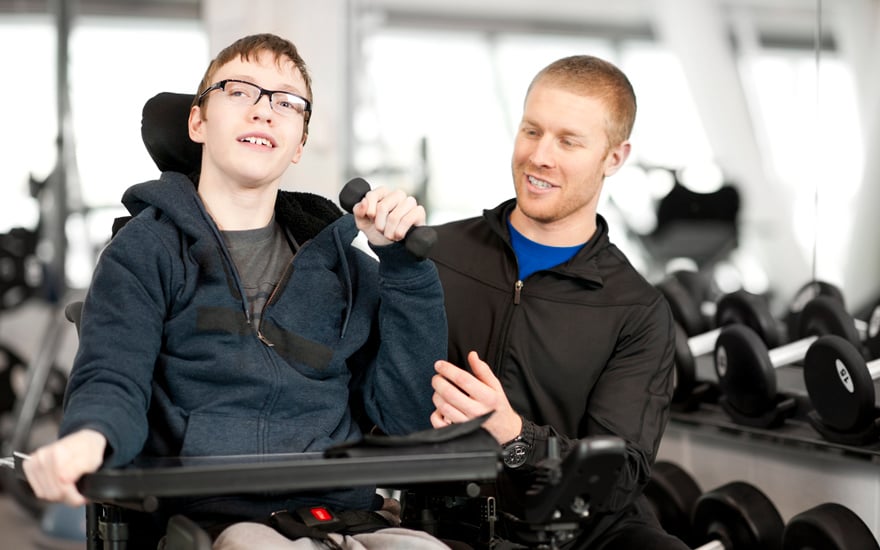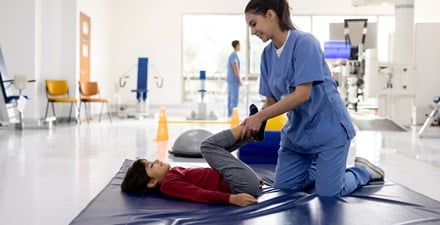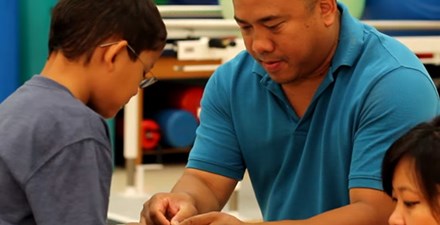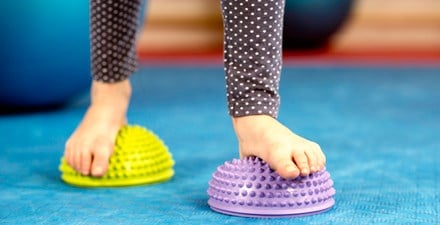Physical Therapy Guide to Muscular Dystrophies in Children
Muscular dystrophies include several genetic disorders. These disorders cause a loss of muscle mass (muscle "wasting"), which leads to increasing muscle weakness over time. The muscles that control the arms and legs are most often involved, but MD can affect other muscles. Each form of MD progresses at a different rate. Several types of MD affect children. Symptoms of MD can begin any time from birth to the teen years. In some cases, such as Duchenne and Becker MD, boys are affected more often than girls. According to one study, Duchenne muscular dystrophy is the most common form in children. An article in Nature Reviews states that DMD occurs in about 1 in 5,000 boys born. Physical therapists design treatment programs for people with MD to help each person reach their full potential.
Physical therapists are movement experts. They improve quality of life through hands-on care, patient education, and prescribed movement. You can contact a physical therapist directly for an evaluation. To find a physical therapist in your area, visit Find a PT.
What Is Muscular Dystrophy?

Muscular dystrophy is a genetic disease. It is caused by a change or mutation in one of the genes in a person’s DNA. It is not caused by an injury or harmful activity. Our genes determine our characteristics and traits. The genes that cause MD control the proteins that are needed for muscle health.
MD causes increasing muscle damage and muscle weakness, along with decreasing muscle size/volume over time. It affects people of all races and ages worldwide. Symptoms of MD can begin any time from birth to the teen years. Although boys have MD more often, girls can have it too. Girls may show less severe symptoms, or they may have no symptoms and just "carry" the gene mutation. Learn more about how genes are inherited (passed from parents to children) below.
According to the National Institutes of Health, there are nine main types of MD with many variations or subtypes. Overall, there are more than 30 different forms of MD. The most common types are:
- Duchenne. This is the most common and severe form of MD among children and into adulthood. It is sometimes called "DMD." It affects mostly males and results in loss of skeletal, heart, and lung muscle. With DMD, dystrophin (a protein in muscle cells) either changes, is missing, or there is not enough produced. Proteins are essential for muscle cell health. When these proteins do not function properly, the muscle cannot repair itself well and becomes weaker.
- Becker. This type of MD is less severe than DMD. It commonly affects the hips, pelvic area, thighs, and shoulder muscles first. This type of MD also affects the heart muscle.
- Myotonic. This is the most common form of MD among adults. It often causes lasting muscle contractions and affects multiple systems, including the:
- Muscles that move the limbs and trunk.
- Digestive system.
- Heart muscles.
- Facioscapulohumeral. This type of MD most often causes weakness in the face, shoulder, and upper arm muscles. Facio means face, scapulo stands for shoulder, and humeral refers to the upper arm. It also can affect the legs.
A child's parents may be carriers of the abnormal gene that causes muscular dystrophy. The NIH reports that this gene may be inherited in three ways:
- Autosomal dominant inheritance. The child receives a normal gene from one parent. From the other parent, who usually has the disorder, they receive a changed (mutated) gene. In this case, a child has a 50% chance of inheriting or getting the mutated gene. Males and females are equally at risk.
- Autosomal recessive inheritance. Both parents carry and pass on the defective gene. Each parent has one mutated gene, but the disorder does not affect either parent. A child has a 25% chance of inheriting or getting both faulty genes, resulting in MD. Each child also has a 50% chance of inheriting one gene becoming a carrier of MD. A carrier would most likely not have any symptoms but can pass MD on to their own children. Males and females are equally at risk.
- X-linked (or sex-linked) recessive inheritance. A mother carries the mutated gene on one of her X chromosomes. Male children inherit an X chromosome from their mother and a Y chromosome from their father. A mother has a 50% chance of passing the mutated X chromosome to her son. If this happens then the son will have MD. Females inherit one X chromosome from each parent. Daughters also have a 50% chance of inheriting the mutated gene from their mom. If they receive the mutated gene from their mom and a healthy X chromosome from their father, they are called carriers. Females who are carriers may show symptoms of MD, but usually the symptoms are mild. Males with the mutated gene cannot pass the X-linked disorder to their sons. They can pass it to their daughters who would then be carriers and may pass the gene on to their children as well.
Signs and Symptoms
All dystrophies are genetic (passed down from the parents), cause muscle weakness, and get worse with time. Many dystrophies cause contractures (shortening of muscles, tendons, or tissues). Contractures affect the joints, the alignment of the spine, and breathing.
Children with MD experience differences and difficulties with their movement abilities. Early signs and symptoms of MD may include:
- Delays in developmental milestones when they are babies and toddlers. These include the ability of a child to learn to sit up, crawl, walk, and run at typical ages. Any of these delays should be examined immediately to determine their cause.
- The Gower’s sign. This describes a child using their hands on their thighs to stand up from the floor. This is often the first sign of pelvic muscle weakness and seen often with DMD.
- Signs of weakness related to MD or possibly DMD such as:
- Problems using stairs.
- Walking with the legs farther apart than typical.
- Being unable to hop on one foot (for those older than 4 years).
- Other issues related to MD, as noted in a PLoS One article, may include:
- Behavioral problems.
- Cognitive (thinking and reasoning) issues.
- Speech and language problems.
A Lancet Neurol article states that up to 30% of people with DMD (about 3 in 10) have behavioral and cognitive problems.
How Is It Diagnosed?
The Centers for Disease Control and Prevention reports that certain MDs do not get identified until ages 3 to 6. However, these disorders can be found earlier. An accurate diagnosis can take a long time. Getting treatment from a physical therapist as early as possible for any muscle weakness or developmental delays can help children with MD reach their full potential.
A medical doctor typically diagnoses MD. To help determine whether a person has MD, a medical doctor may:
- Order blood tests to see the levels of the muscle protein and other factors.
- Notice a blood test ordered for other reasons shows a change in muscle proteins.
- Conduct a muscle biopsy.
- Refer the child to specialists for genetic testing and counseling to make sure of the diagnosis.
If there is family history of MD, genetic testing can be helpful to do before getting pregnant. Genetic counseling can help parents determine if they have the mutated gene causing the disorder. Tests during pregnancy carry some risk but may help expecting parents learn if their unborn child has MD. Newborn screening also should be done when the family has a history of MD.
Other methods for diagnosing MD include tests such as:
- Diagnostic imaging.
- Strength and exercise testing.
- Other diagnostic tests to find out the type of MD.
New tests are constantly in development.
If your child is receiving physical therapy for a developmental delay or low muscle tone, and shows clinical signs of MD, your physical therapist may refer them back to their doctor to rule out MD.
Signs and symptoms that may suggest a need for follow-up with your doctor can include:
- Unusual muscle weakness.
- A Gower’s sign (putting hands on thighs to stand up).
- Delayed walking.
- Trouble with or inability to run, climb stairs, or jump.
- Falling often.
- Walking on tiptoes.
- Delayed speech and language.
- Delayed motor development (or difficulty learning new movement skills).
- Head lag (problems controlling the head or neck when picked up from lying down).
How Can a Physical Therapist Help?
Physical therapists help children with MD maintain as much mobility and function as possible. Physical therapists help children with MD and their families manage complications such as muscle weakness, shortening, and stiffness. Each child with MD has unique needs based on age, the type of dystrophy, and the progression of their symptoms. Physical therapists work with children and their families in a clinic, at home, and at school. They also team with other health care providers to develop treatment plans specific to each child’s needs. A team approach to treatment can ensure the best care and help your child reach their full ability.
A physical therapist is an important partner in the overall health of anyone with MD. Physical therapy should begin as soon as possible after diagnosis, and before joint or muscle tightness develops.
Each physical therapy treatment plan is designed to meet the child's needs using a family-centered approach. Physical therapists work with each child to:
- Keep muscles as flexible as possible. This helps to reduce or prevent contractures and makes it easier to move and be comfortable.
- Keep muscles functioning as well as possible. This makes it easier to do daily activities with less help from others.
- Teach the right kind of movement for safety and independent function throughout all stages of life.
- Guide families to the right equipment to help support the body and increase independence and safety. These might be walking aids, braces, wheelchairs, or other devices.
Physical therapists know the importance of addressing your child's unique needs. They value a team approach that includes working with all involved health care providers. This holistic care helps to ensure mobility throughout the life span.
Evaluation
Your child's physical therapist will perform an evaluation that includes taking a detailed birth and developmental history. They also will ask about the child's overall health and parental concerns. Your child’s physical therapist also will conduct a physical exam and perform specific tests to assess your child's motor development skills, such as:
- Sitting.
- Crawling.
- Getting up to stand.
- Walking.
They also may conduct other tests to evaluate how the disorder has progressed over time. This can help predict when care changes or mobility aids (wheelchair, bracing) might be needed.
Treatment
Physical therapists work with children who have MD to:
- Prevent or reduce joint contractures and muscle stiffness.
- Maintain or improve cardiorespiratory health and muscle strength.
- Adapt activities at the child's home or school to allow fun and participation. They can recommend changes ranging from recess to sports to daily routines.
- Increase tolerance of daily activities.
- Encourage social and emotional health through participation in community activities.
Physical therapist treatment for MD may include:
Passive and active stretching. Your physical therapist will guide your child through gentle stretches of their legs, arms, and trunk. They also will teach you and your child how to do these stretches at home. Doing them regularly can increase joint flexibility (range of motion) and prevent or delay the onset of contractures.
Exercises to maintain strength. Your physical therapist will teach you and your child exercises to maintain muscle and trunk strength. Regular physical activity is important for MD and for a child’s overall health. Overuse can damage muscles, and your physical therapist can dose exercises appropriately. Seeing a physical therapist early can help you identify the best activities for your child to do and to avoid. Your therapist will identify games and fun tasks that they can do safely within their ability. As your child grows, your physical therapist will identify new activities to reduce obesity risk and improve heart health. Activities such as biking and swimming are great to consider. Your physical therapist will help you make sure these activities do not cause too much strain or fatigue. They also will teach children how to use good posture and body mechanics throughout their life.
Exercises for breathing. Your physical therapist may provide a program to help your child keep good respiratory strength and chest mobility. If needed, they also may work with a respiratory therapist or speech therapist to design the right program for your child’s needs.
Improving developmental skills. Your physical therapist will help your child learn to master skills such as crawling, getting up to stand, and walking. They will provide a plan of care that is appropriate for your child's developmental level and needs.
Physical fitness and activity. Your physical therapist will suggest specific exercises and community involvement to promote your child's good health. When needed, they may prescribe wheelchairs, splints and braces, and home devices to aid mobility. Physical therapists also can help families find equipment for recreation, such as an adapted bicycle or tricycle.
Your child may receive physical therapy at home or in a community center, school, or a physical therapy outpatient clinic. Your child's needs will vary greatly as they age, and your physical therapist will adjust treatments as needed. Physical therapists team with other health care providers, such as speech/language pathologists and occupational therapists, to address each child’s needs as treatment priorities shift.
If your child needs surgery for scoliosis or contractures, your physical therapist can help evaluate the need for equipment, aid devices, or bracing during recovery. Your physical therapist also can work on early movement after surgery to help speed recovery and maximize independence.
Can This Injury or Condition Be Prevented?
Muscular dystrophies are genetic disorders that cannot be prevented. Excellent prenatal care is important for all pregnancies.
According to an article in Muscular Dystrophy News Today, families with a known, inherited MD may find genetic counseling helpful. However, many times an MD mutation occurs in the womb when neither parent has a known history of the disorder. Some women may want to have a test to detect MD in early pregnancy.
If MD is detected in an unborn baby, the physical therapist and other health care providers can educate expectant parents. Early physical therapy can help by providing therapeutic techniques to prevent or reduce some of the complications of MD after birth.
The outlook for people with MD varies based on the type and stage of the disorder. Mild cases can progress slowly over the life span. Others may cause severe muscle weakness and impact a person’s function. Some children with MD die in infancy, while others live into adulthood with mild to moderate disability.
Physical therapists are dedicated to ensuring that children with MD and their families are not alone. They work tirelessly to help each person reach their full abilities.
What Kind of Physical Therapist Do I Need?
All physical therapists are prepared through education and experience to treat a variety of conditions or injuries. You may want to consider:
- A physical therapist who is experienced in pediatrics and MD. Many children’s hospitals have centers for treating children with neuromuscular disorders and employ experienced pediatric physical therapists.
- You may want to work with a physical therapist at a specialty center and a physical therapist at a local pediatric practice who can work with you and your child at home, school, or in your community.
- A physical therapist who is a board-certified clinical specialist in pediatric physical therapy or who has completed a residency or fellowship in pediatric physical therapy. This physical therapist has advanced knowledge, experience, and skills that may apply to neuromuscular disorders, such as MD.
You can find physical therapists in your area with these credentials and clinical expertise on Find a PT, a tool built by the American Physical Therapy Association.
General tips when you are looking for a physical therapist (or other health care provider):
- Ask family, friends, and other health care providers to recommend a physical therapist.
- Ask about the physical therapist's experience treating muscular dystrophies before you make an appointment.
- Be prepared to describe your child’s symptoms, any concerns you have, and your goals in as much detail as possible on your first visit.
Additional Resources
- Duchenne Muscular Dystrophy: Care Guide for Families. Various Duchenne organizations, published in 2018. Accessed March 15, 2022.
- National Institute of Neurological Disorders and Stroke. Muscular dystrophy research. Accessed March 15, 2022.
- CureDuchenne, a nonprofit organization leading the fight to cure Duchenne muscular dystrophy by funding transformative research and educating those affected by the disease. CureDuchenne Certified Physical Therapist program ensures proper care by qualified therapists. Accessed March 15, 2022
- Muscular Dystrophy Association, a nonprofit health agency dedicated to finding treatments and cures for many types of muscular dystrophy. Accessed March 15, 2022
- Muscular Dystrophy Association. Duchenne muscular dystrophy. Accessed March 15, 2022.
- Muscular Dystrophy Association. Congenital muscular dystrophy. Accessed March 15, 2022.
- Cure CMD. Congenital Muscular Dystrophy patient group funding research and providing resources. Accessed March 15, 2022.
- Wang CH, Bonnemann CG, Rutkowski A, et al. Consensus statement on standard of care for congenital muscular dystrophies. J Child Neurol. 2010;25(12):1559–1581. Article Summary on PubMed.
The APTA Academy of Pediatric Physical Therapy contributed to this consumer resource. It is for informational purposes only and is not intended to represent the position of APTA Pediatrics.
The American Physical Therapy Association believes that consumers should have access to information that could help them make health care decisions and also prepare them for a visit with their health care provider.
The following articles and resources provide some of the best scientific evidence related to the treatment of muscular dystrophy. The article titles are linked either to a professional organization or to a PubMed* abstract of the article or to free full text, so that you can read it or print out a copy to bring with you to your health care provider.
Muscular Dystrophy News Today. Genetic testing and genetic counseling. https://musculardystrophynews.com/muscular-dystrophy-diagnosis/genetic-testing/. Updated January 9, 2022. Accessed March 18, 2022.
Duan D, Goemans N, Takeda S, et al. Duchenne muscular dystrophy. Nature Reviews. 2021;7(13):1–19. Article Summary on PubMed.
National Institute of Child Health and Human Development. What are the types and symptoms of muscular dystrophy? https://www.nichd.nih.gov/health/topics/musculardys/conditioninfo/types. Updated November 9, 2020. Accessed March 16, 2022.
National Institute of Child Health and Human Development. What causes muscular dystrophy? https://www.nichd.nih.gov/health/topics/musculardys/conditioninfo/causes. Updated November 9, 2020. Accessed March 16, 2022.
Centers for Disease Control and Prevention. Muscular Dystrophy data and statistics. https://www.cdc.gov/muscular-dystrophy/research/summary.html. Updated January 7, 2025. Accessed March 14, 2025.
Birnkrant DJ, Bushby K, Bann C, et al. Diagnosis and management of Duchenne muscular dystrophy, part 1: diagnosis, and neuromuscular, rehabilitation, endocrine, and gastrointestinal and nutritional management. Lancet Neurol. 2018;17(3):251–267. Article Summary on PubMed.
Birnkrant D, Bushby K, Bann C et al. Diagnosis and management of Duchenne muscular dystrophy, part 3: primary care, emergency management, psychosocial care, and transitions of care across the lifespan. Lancet Neurol. 2018;17(4):347–361. Article Summary on PubMed.
Centers for Disease Control and Prevention. Genetic counseling. https://www.cdc.gov/genomics-and-health/counseling-testing/genetic-counseling.html. Updated January 31, 2025. Accessed March 14, 2025.
Taylor P, Betts G, Maroulis S, et al. Dystrophin gene mutation location and the risk of cognitive impairment in Duchenne muscular dystrophy. PLoS One. 2010;5(1):e8803. Article Summary on PubMed.
*PubMed is a free online resource developed by the National Center for Biotechnology Information (NCBI). PubMed contains millions of citations to biomedical literature, including citations in the National Library of Medicine’s MEDLINE database.
Expert Review:
May 29, 2022
Revised:
Oct 14, 2022
Content Type: Guide
Muscular Dystrophy
PT, PhD, board-certified pediatric clinical specialist
Jennifer Wallace Valdes
PT
Lauren Johnson
PT, DPT, board-certified pediatric clinical specialist, on behalf of the Academy of Pediatric Physical Therapy
You Might Also Like...
Health Tips
Physical Therapy and Duchenne Muscular Dystrophy: 5 Things You Should KnowApr 11, 2023
Duchenne muscular dystrophy is a rare disease that causes muscles to degenerate. While there is no cure at this time, treatments and therapies, including
Patient Stories
Physical Therapy Provides Independence For Boy With Muscular DystrophyJul 23, 2021
Marcel works with his physical therapist to maintain his strength and learn how to overcome any obstacles he may face.
Podcast
Back to School: Access to Physical Therapy in the ClassroomAug 24, 2014
Getting through the school day is as challenging as the educational material for many kids. But for those with special needs, access to physical therapy


